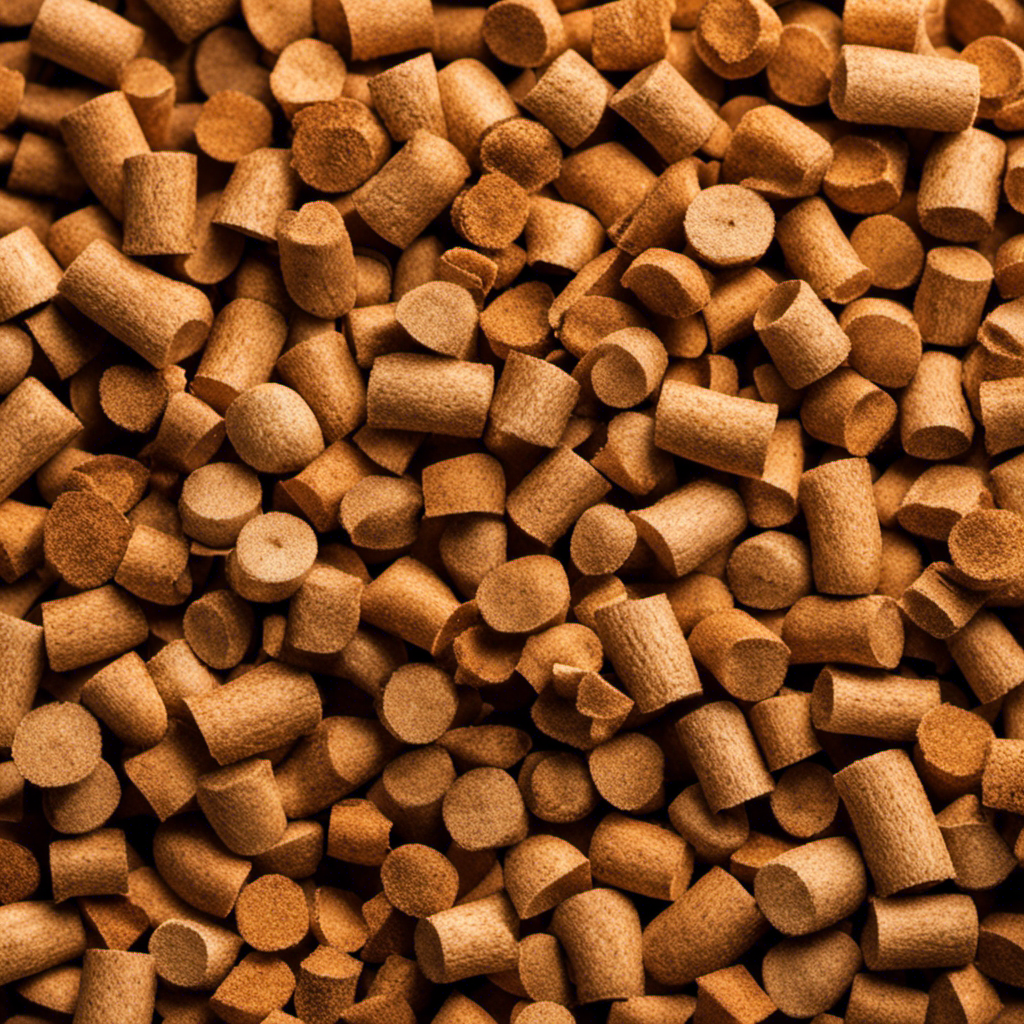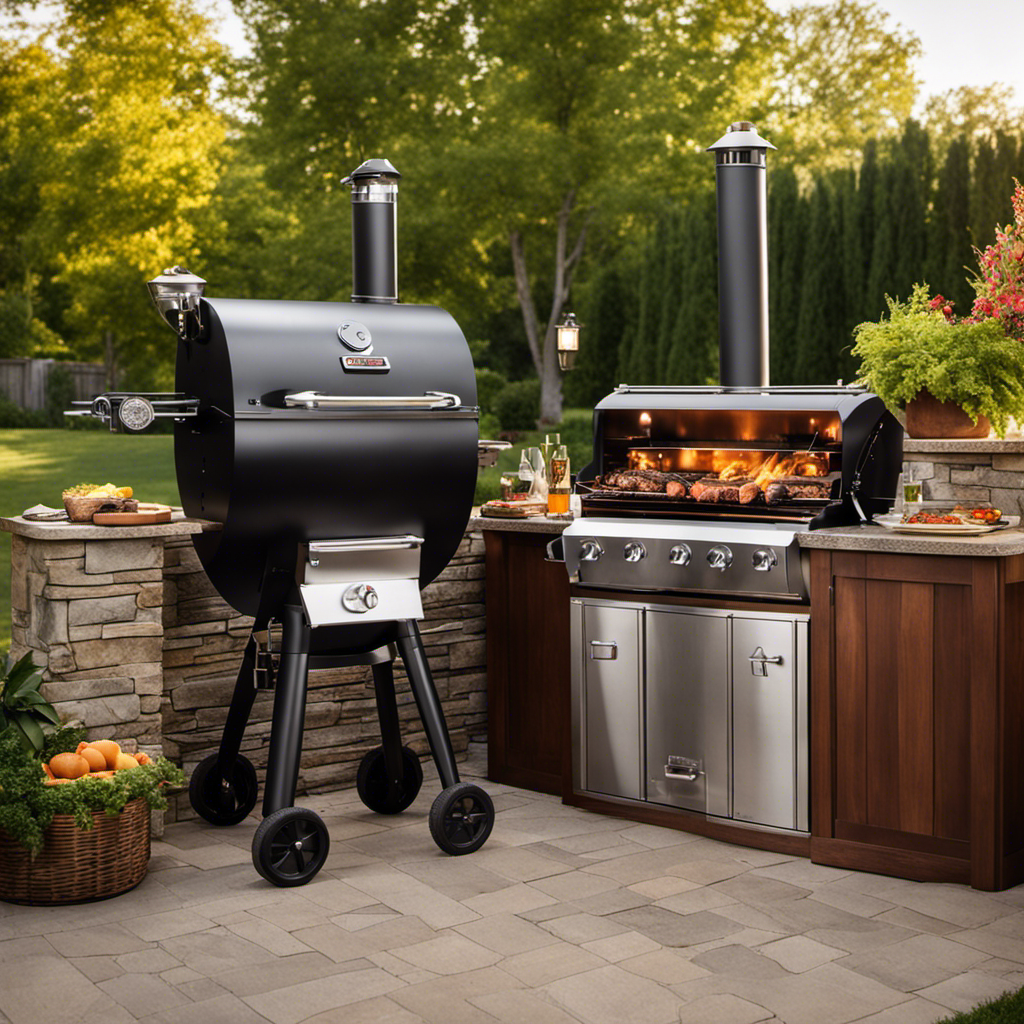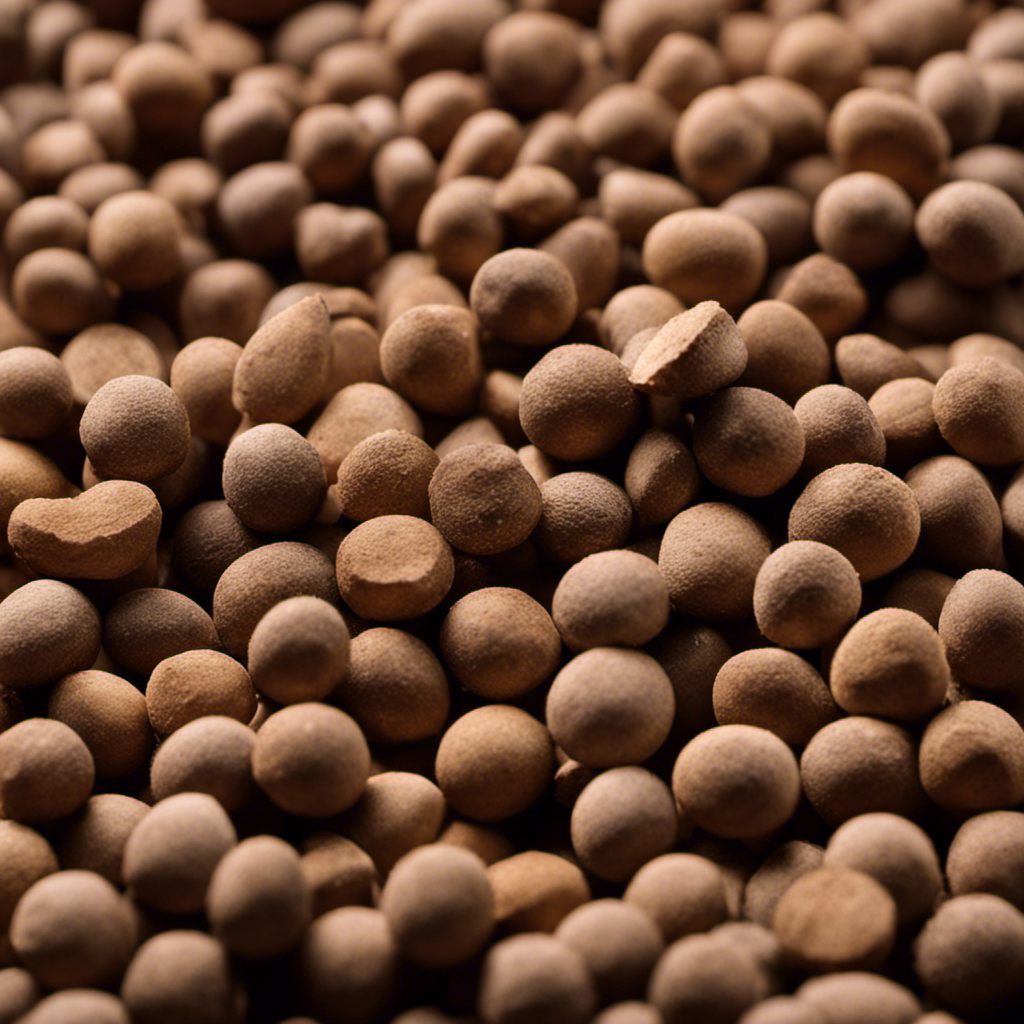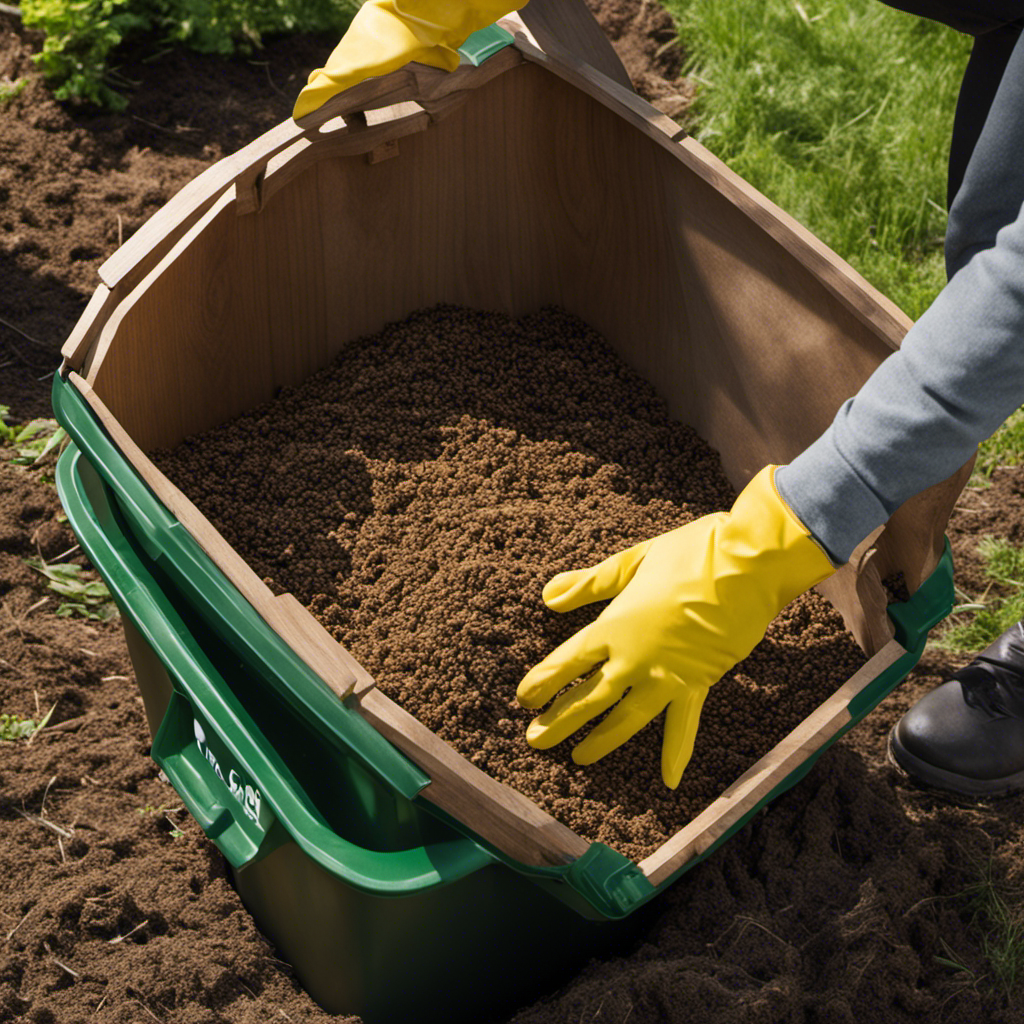As someone who has experience with using pellet stoves, I have discovered that creating your own wood pellets not only saves money but also provides a great sense of fulfillment.
In this article, I will guide you through the intricate process of crafting high-quality wood pellets for your pellet stove.
From selecting the ideal wood to testing the final product, every step requires precision and expertise.
So grab your gear and let’s delve into the world of pellet production, where we turn nature’s gift into efficient warmth.
Key Takeaways
- Hardwoods like oak, maple, and cherry are ideal choices for making wood pellets for pellet stoves as they produce denser pellets that burn longer and generate more heat.
- Proper preparation of wood, including debarking, drying, and grinding, is crucial for optimal pellet production.
- Grinding and chipping wood chips to achieve uniform size and consistency is important for efficient feeding into the pelletizing stage.
- Using the right equipment that meets quality and safety standards is essential for efficient wood pellet production.
Choosing the Right Wood for Pellet Production
You’ll want to consider the type of wood you’re using when making pellets for your pellet stove. The wood pellet density plays a crucial role in determining the efficiency and performance of your stove.
Hardwoods such as oak, maple, and cherry are excellent choices due to their high density. They produce denser pellets that burn longer and generate more heat compared to softwoods like pine or spruce. Moreover, using hardwoods reduces the frequency of pellet stove maintenance as they create less ash residue.
To ensure optimal results, it’s important to properly prepare the wood for pellet making. This involves steps such as debarking, drying, and grinding the wood into sawdust or chips.
Preparing the Wood for Pellet Making
When it comes to preparing wood for pellet making, there are a few key points to keep in mind.
First, selecting the right type of wood is crucial for optimal pellet production.
Second, ensuring that the wood has the proper moisture content is essential for efficient processing.
Lastly, properly grinding and chipping the wood will result in uniform particle size and better quality pellets.
Wood Selection Tips
Choosing the right wood for your pellet stove is essential in ensuring optimal performance. Not all types of wood are suitable for pellet stoves, as they can affect the efficiency and overall functionality of the appliance.
Here are some key tips to consider when selecting wood for your pellet stove:
-
Hardwood: Opt for hardwood varieties like oak, maple, or birch. These woods have a higher density and provide better heat output compared to softwoods.
-
Low moisture content: Ensure that the wood has a moisture content below 20%. Moisture-rich wood will not burn efficiently and can lead to creosote buildup in your stove.
-
Quality pellets: Consider using high-quality wood pellets specifically designed for pellet stoves. These pellets are made from compressed sawdust and offer consistent heat output.
By choosing the right type of wood and ensuring it has proper moisture content, you can maximize the efficiency of your pellet stove and enjoy a warm and cozy home without compromising on performance.
Now let’s move on to discussing the importance of maintaining proper moisture levels in your wood pellets without skipping a beat.
Proper Moisture Content
To ensure optimal performance, it’s important to maintain the proper moisture content in your selected wood for maximum efficiency. Proper moisture content is crucial for successful wood pellet storage and pellet stove maintenance.
When the moisture content of wood pellets is too high, they become prone to mold and decay, which can lead to inefficient combustion and damage to your pellet stove. On the other hand, if the moisture content is too low, the pellets will burn too quickly and produce less heat.
To maintain the ideal moisture content, store your wood pellets in a dry environment with low humidity levels. Regularly check the moisture level using a moisture meter and adjust as needed by adding or removing water from the storage area.
Now that we have discussed maintaining proper moisture content, let’s move on to grinding and chipping for further processing of the wood pellets.
Grinding and Chipping
You can achieve the ideal size and consistency for your wood by using a grinder or chipper. In the process of wood pellet production, grinding and chipping are crucial steps in preparing the raw material for manufacturing high-quality pellets.
The grinder or chipper breaks down the wood into smaller pieces, ensuring uniformity in size. This is essential because it allows for efficient feeding into the next stage of production. By reducing the wood to a consistent size, it becomes easier to convert it into pellets with minimal energy consumption and improved overall efficiency.
Once the wood chips have been processed through grinding or chipping, they are ready for further treatment, such as drying to reduce moisture content and enhance pellet quality.
Transitioning seamlessly into the subsequent section about ‘grinding and drying the wood chips’, let’s now focus on how proper drying techniques affect wood pellet manufacturing.
Grinding and Drying the Wood Chips
When it comes to grinding wood chips for pellet production, optimal techniques are crucial in achieving the desired particle size and consistency. Efficient wood chip drying is equally important to ensure that the moisture content is within the ideal range for pellet making.
In this discussion, we will explore various equipment options available for wood processing, such as grinders and dryers, that can help streamline the grinding and drying processes for maximum efficiency.
Optimal Grinding Techniques
Using a fine mesh screen will ensure that your wood pellets are ground to the optimal size for efficient combustion in your pellet stove.
When it comes to grinding wood chips, having the right equipment is crucial. A hammer mill is commonly used for this process, as it allows for precise control over particle size. The wood chips are fed into the hammer mill, where they are pulverized by rotating hammers.
The resulting ground material passes through the fine mesh screen, which ensures that only particles of the desired size make it through. This step is essential because if the particles are too large or too small, they may not burn efficiently in your pellet stove.
Now that we have achieved optimal grinding techniques, let’s move on to discussing efficient wood chip drying methods.
Efficient Wood Chip Drying
Now that we have covered optimal grinding techniques, let’s move on to the next step in making wood pellets for your pellet stove: efficient wood chip drying.
Properly dried wood chips are crucial for producing high-quality pellets. Wood chip storage is an essential part of this process as it ensures that the chips remain dry and free from moisture before they are used.
To maintain the efficiency and longevity of your pellet stove, regular maintenance is required. This includes cleaning the ash regularly to prevent buildup and ensuring proper airflow through the system. Additionally, inspecting and cleaning the chimney or vent pipe is important to avoid any blockages that could hinder its performance.
In order to efficiently process wood for pellet production, it is necessary to have the right equipment. Now let’s explore the various types of equipment used in wood processing without compromising quality or safety standards.
Equipment for Wood Processing
To efficiently process wood for pellet production, it’s important to have the right equipment that meets quality and safety standards.
In wood pellet production, there are several key pieces of equipment that play a crucial role. First and foremost is the wood chipper, which is used to break down larger pieces of wood into smaller chips.
These chips are then fed into a hammer mill, where they are further reduced in size to create a finer powder.
From there, the wood powder is mixed with binders to create pellets that hold their shape during combustion in pellet stoves. This ensures efficient burning and reduces maintenance requirements for pellet stove users.
Mixing the Wood Powder With Binders
After you’ve obtained the wood powder, it’s time to mix it with binders. This step is crucial in ensuring that the wood pellets have the necessary durability and cohesiveness. Here are four important factors to consider when selecting binders and employing proper mixing techniques:
-
Binder selection: Choose a binder that is eco-friendly and non-toxic, as this will ensure the safety of both the environment and those handling the pellets.
-
Mixing equipment: Utilize a high-speed mixer or blender to thoroughly combine the wood powder and binders. This will help achieve a homogeneous mixture, resulting in consistent pellet quality.
-
Binder ratio: Determine the appropriate binder-to-wood ratio based on your desired pellet characteristics. Too much binder can lead to excessive ash production, while too little may result in weak pellets.
-
Mixing duration: Mix the wood powder and binders for an adequate amount of time to ensure proper bonding. Overmixing can cause excessive heat generation, while undermixing may result in poor pellet integrity.
By carefully considering these factors, you can create a well-mixed wood powder-binder combination ready for pelletization.
Transitioning into ‘Pelletizing the Wood Powder Mixture,’ we can now move on to forming these well-prepared mixtures into compacted pellets without any further delay.
Pelletizing the Wood Powder Mixture
Once you have achieved a well-mixed wood powder-binder combination, it’s time to compact the mixture into pellets. Pelletizing techniques play a crucial role in this step of the process. There are various methods available for pelletizing, including flat die and ring die pellet mills. These machines use pressure and heat to form the mixture into small cylindrical shapes.
Pellet density control is important during this stage to ensure consistent quality and performance of the resulting pellets. By adjusting factors such as compression ratio, moisture content, and feed rate, you can achieve the desired density for your wood pellets.
Once the pellets are formed, they need to be cooled and screened to remove any fines or irregularly shaped pieces before being packaged or used in a pellet stove.
TRANSITION: Now that we have successfully pelletized the wood powder mixture, let’s move on to cooling and screening the pellets without wasting any time.
Cooling and Screening the Pellets
After the wood powder mixture is pelletized, the next step in the process of making wood pellets for a pellet stove is cooling and screening.
Pellet cooling techniques are crucial to ensure that the pellets have a low moisture content and are durable enough for storage and transportation. One common method is using a pellet cooler, which uses ambient air to cool down the pellets gradually. This helps prevent excessive moisture absorption and maintains their structural integrity.
Once cooled, the pellets go through a screening process to remove any fines or oversized particles. The goal is to achieve uniform size distribution, ensuring optimal combustion efficiency in the pellet stove. This step involves passing the pellets through sieves with different mesh sizes to separate them into desired categories.
With proper cooling and screening, we can now move on to storing and packaging the wood pellets efficiently without compromising their quality or performance.
Storing and Packaging the Wood Pellets
To store and package your wood pellets efficiently without compromising their quality or performance, you’ll need to consider proper storage conditions and suitable packaging materials.
Wood pellet storage is crucial to maintain the integrity of the pellets and prevent any moisture absorption or degradation. It is best to store the pellets in a dry, well-ventilated area away from direct sunlight and extreme temperatures.
Additionally, using airtight containers or bags can help preserve the quality of the pellets by preventing exposure to air and moisture.
When it comes to pellet packaging, sturdy plastic bags or containers are commonly used due to their durability and ability to protect the pellets during transportation and handling.
Now let’s move on to testing the quality of the wood pellets before they are used in a pellet stove.
Testing the Quality of the Wood Pellets
After storing and packaging the wood pellets, it is important to test their quality before using them in a pellet stove. Two key factors that determine the quality of wood pellets are their density and moisture content. Wood pellet density affects combustion efficiency, while moisture content affects both combustion efficiency and storage stability.
To measure wood pellet density, a simple method is to weigh a known volume of pellets and calculate the density by dividing the weight by the volume. This information can be used to compare different batches or brands of wood pellets.
Measuring pellet moisture content is crucial because high moisture levels can lead to incomplete combustion, increased emissions, and potential damage to the stove. Moisture meters specifically designed for wood pellets can accurately measure their moisture content.
By testing these parameters, you ensure that your wood pellets are of high quality and will provide efficient heat in your pellet stove.
Transitioning into the subsequent section about ‘tips and tricks for efficient pellet stove operation’, it’s important to understand how proper maintenance can further enhance the performance of your stove.
Tips and Tricks for Efficient Pellet Stove Operation
Understanding how to properly maintain and operate your pellet stove can greatly enhance its performance and efficiency. Here are some tips for cleaning pellet stoves and troubleshooting common issues:
-
Cleaning:
-
Regularly clean the firepot to prevent ash buildup and ensure proper combustion.
-
Clean the exhaust vent and chimney annually to remove any blockages or debris.
-
Troubleshooting:
-
If your pellet stove isn’t igniting, check the power supply and make sure the fuel hopper is adequately filled.
-
If you’re experiencing poor heat output, check the combustion blower for any obstructions or damage.
-
In case of excessive smoke or soot, adjust the air intake damper to achieve optimal airflow.
Frequently Asked Questions
How Long Do Wood Pellets Typically Last in a Pellet Stove?
Wood pellets typically last around 4 to 6 hours in a pellet stove, depending on the heat setting and size of the stove. Proper wood pellet storage is essential for maintaining their quality and efficiency. Using wood pellets in a pellet stove offers advantages such as cleaner burning and higher energy efficiency.
Are There Any Safety Precautions I Should Take When Using a Pellet Stove?
When using a pellet stove, it’s crucial to prioritize safety. Make sure to have the necessary safety equipment, such as gloves and goggles, and ensure proper ventilation to prevent carbon monoxide buildup.
Can I Use Different Types of Wood Together to Make Wood Pellets?
Yes, you can use different types of wood together to make wood pellets. The advantage of using mixed wood for pellet production is that it can create a more balanced and efficient fuel source for your pellet stove.
How Do I Know if the Wood Pellets I’ve Made Are of Good Quality?
To determine wood pellet quality, check for low ash content and high heat output. Proper storage is crucial to maintain quality. Common problems include excessive moisture, inconsistent size, and poor combustion efficiency.
Are There Any Maintenance Tasks I Should Perform Regularly on My Pellet Stove to Keep It Running Efficiently?
To keep my pellet stove running efficiently, regular maintenance tasks are necessary. This includes cleaning the pellet stove and troubleshooting any issues that may arise. It’s important to stay on top of these tasks for optimal performance.
Conclusion
In conclusion, making wood pellets for your pellet stove is a precise and technical process that requires careful consideration of various factors.
From choosing the right wood to testing the quality of the final product, every step plays a crucial role in ensuring efficient operation.
Just like a well-oiled machine, when all the pieces come together smoothly, your pellet stove will roar to life and provide warmth like a blazing sun on a cold winter’s day.
So follow these steps diligently and let your pellet stove shine bright!











